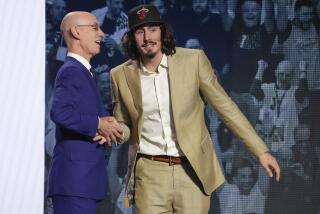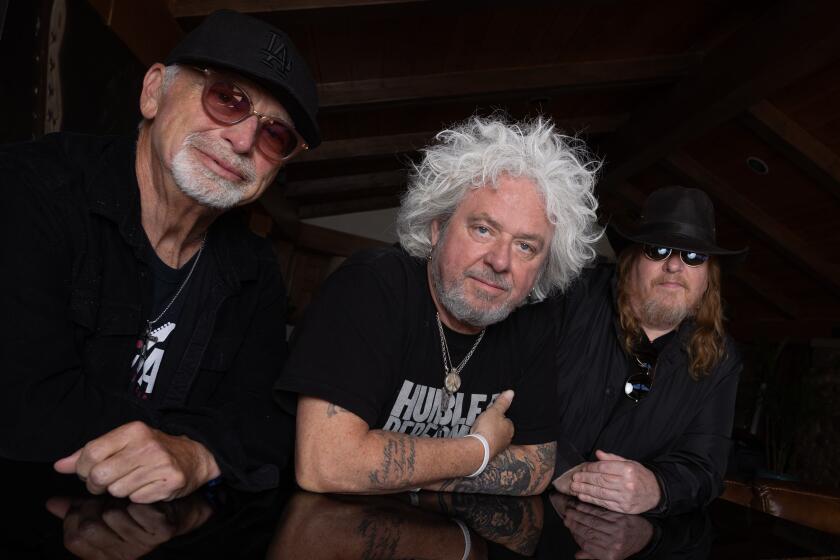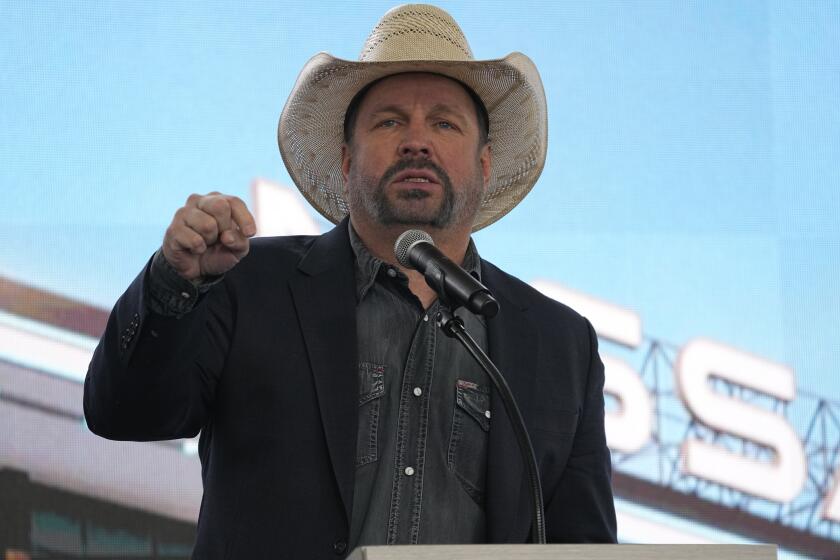Illinois Jacquet, 81; Innovative Saxophonist
Illinois Jacquet, a tenor saxophonist whose inventive solo on “Flying Home” helped make the song a jazz standard, died Thursday at his home in New York City of an apparent heart attack. He was 81.
Jacquet was also involved in one of the most influential performances in jazz, the first Jazz at the Philharmonic concert, which was produced by promoter Norman Granz in Los Angeles in 1944. A tape of that concert would become the first commercially released live jazz recording.
Among the first to employ the saxophone technique known as honking or screeching, Jacquet came to prominence in a generation of players who used musical showmanship to create crowd-pleasing excitement.
Most comfortable in the big-band format, he played with many of the giants of music in his seven-decade career and recorded more than 300 original compositions, including three of his biggest hits, “Black Velvet,” “Robbins’ Nest” and “Port of Rico.”
He first came to fame as a 19-year-old playing with vibraphonist Lionel Hampton, who had just started his own big band. Nat King Cole, a friend of Jacquet who was known at the time only as a jazz pianist, had recommended Jacquet to Hampton in 1940.
Hampton agreed to take Jacquet if he switched to tenor saxophone from the alto saxophone, which he had been playing since his days growing up in Houston. The reason was simple: The band already had an alto player.
In need of a job, Jacquet agreed.
A year later, Hampton took Jacquet into a recording studio. While playing “Flying Home,” Jacquet launched into an 80-second solo -- a single note in syncopation, repeated 12 times -- that astonished jazz fans.
“It was raw, lascivious, embodying the worst fears parents had about jazz,” Jeff McCord wrote in Texas Monthly magazine in November 2002.
In his book “Rhythm-a-ning,” critic Gary Giddins wrote: “Jazz was now finally as erotic and vulgar as the women’s magazine Ladies Home Journal had always warned, and the crowds that came to hear Jacquet with Hampton ... expected nothing less than a shot to the glands.”
Jacquet never expected there to be such a demand for his solo night after night while performing with Hampton. He found it overwhelming and exhausting, and he left the band in 1943.
“Sometimes you have to quit to save your life,” Jacquet told McCord. “I looked in the mirror and said, ‘You’re dying and [Hampton is] is getting rich.’ ”
After leaving the Hampton orchestra, Jacquet played for a time with Cab Calloway’s and Count Basie’s bands.
Between stints with those great bandleaders, however, Jacquet returned to Los Angeles, where he appeared alongside saxophonist Lester Young, trumpeter Harry “Sweets” Edison and guitarist Barney Kessel in the Academy Award-nominated short film by noted photographer Gjon Mili, “Jammin’ the Blues” (1944).
And he became a featured member of Granz’s groundbreaking Jazz at the Philharmonic groups. Performing during a time when segregated seating was the norm, the groups would play only to audiences in which all races were seated together.
Jacquet was among the headliners at the first Jazz at the Philharmonic concert at Philharmonic Hall in Los Angeles on July 2, 1944. The event was a fundraiser for the Latino youths wrongly convicted in the notorious Sleepy Lagoon murder case.
A tape of that concert, which included performances by Cole, Benny Carter, Les Paul and Jacquet -- whose 2 1/2-minute solo on “Blues (Part Two)” was considered a highlight of the night -- is acknowledged as the first commercially released live jazz recording.
The saxophonist was born Jean-Baptiste Illinois Jacquet in Broussard, La., the son of a French-Creole father and a Sioux mother. He once told Associated Press that he was named Illinois because one of the nurses was a native of that state and thought one of his names should be American Indian.
His family moved to Houston when he was a toddler, and he performed at the age of 3 as a tap dancer with his father’s band.
He learned to play the drums at an early age but switched to the alto saxophone in high school and soon was playing with a leading local band.
He left Houston in his late teens and moved to Los Angeles.
Jacquet led his own bands on a number of occasions throughout his career and also took up the bassoon. His post-’50s playing showed a range of styles, and he became known as an exceptional ballad interpreter.
He performed at the White House for Presidents Carter and Reagan and in 1993 played “C Jam Blues” there with amateur saxophonist President Clinton.
Jacquet’s last engagement was July 16, when he led his band at Lincoln Center in New York City.
More to Read
The biggest entertainment stories
Get our big stories about Hollywood, film, television, music, arts, culture and more right in your inbox as soon as they publish.
You may occasionally receive promotional content from the Los Angeles Times.









